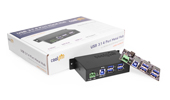Asynchronous communication is a form of computer control timing protocol. It utilizes an indication signal that tells the devices that the previous operation has been completed. Upon receiving this indication signal, the next operation will begin. This was the technology that serial commutation devices used for decades before USB rose to replace RS232 and RS485 as the primary communications standard today. While much lower than USB, it’s is in comparison much simpler.
RS232 and RS485 serial communications use the start and stop bits to organize the sending of information. Synchronous data communication, on the other hand, means that the devices are synchronized at the start, and then data is sent in one continuous stream. RS232 are in a state of constant communication regarding each bit of information, however.
While an RS232 and RS485 device is waiting for the start bit to signal that it is time to send data, the port is idle, or in what is also known as a mark state. No communication is taking place and the “waiting” state is given a value of 1. RS232 and RS485 use bipolar data, which means they have both a negative and a positive voltage. The marked state, or idle state, is therefore 1, and once the start bit arrives and is received, the state changes to 0, or the active state.
In the 0 or active state, a stream of RS232 bytes of serial commutation data is sent until another stop bit is received, which signal then terminates the communication again.
All of this communication is taking place between two devices, commonly referred to as DTE and DCE:
- DTE: Data Terminal Equipment
- Often a Modem
- DCE: Data Communications Equipment
- Usually a Personal Computer
The Connection
An RS232 connection is formed with a cable that is limited in length to about 25 feet, a hallmark of the first serial commutations. The DCE device will typically have a 25 pin male RS232 connection. The DTE device will have a similar RS232 connection port, yet a DTE utilizes a female 25 pin port, and this is the port that is the point of reference for the connection and all of its communications. The configuration and assignment is dependent upon how the DTE device is operating.
The number 1 pin in the port is the protective ground connection on both the DTE and DCE devices, and with all of the pins, they correlate but PIN number between both devices. The number 2 pin is a transmitting data pin, also known as TD, and it sends outgoing data off via this point of connection towards the DCE device (usually a computer). On the DCE device, pin 2 of the 25 pin connection is, therefore, the receiving pin. The DTE device’s RS232 data receiving pin is pin number 3, which, as you might expect, is the data sending pin for the DCE device.
As the RS232 or RS485 connection begins sending data between the DTE and DCE devices, a hardware flow control is enabled, enabling additional lines.
A hardware flow control describes the process of preventing too fast communication of bytes, which would overrun the computer, terminal, or modem. Overrunning results in the device not being able to process the bytes it’s receiving, which results in losing bytes or errors. There are multiple types of flow control including hardware and software. Hardware flow control usted a dedicated signal wire.
These additional lines are that are enabled as flow control is managing the flow of data effectively are RTS and CTS:
- RTS: Request to Send line
- CTS: Clear to Send line
The activation of the RTS and CTS lines causes the DTE to communicate with its DCE device, and information is allowed to be sent. The DCE device will have a specific buffer amount that determines what the DTE device will do next – if it is not at its buffer’s capacity, the DTE will send RS232 data because it will be in a mark state. DTE devices only at this point send the data, because it will have sent a request via the RTS wire on pin 4.
Two more data control lines are DTS and DSR:
- DTS: Data Terminal Ready
- DSR; Data Set Ready
The two lines complement each other and operate in a similar fashion to the RTS and CTS. They were designed with the original function of providing an additional mode for RS232 hardware flow control (aka handshaking). The DSR is assigned to pin 6, typically, and the DTR is assigned to pin 20.
However, DTS and DSR lines are not frequently used today because the hardware flow control of the RTS and CTS is sufficient for nearly all applications and this fact was not anticipated in the original design.
This asynchronous commutation allows RS232 and RS485 to send information and conduct serial communications with a high rate of accuracy. Their reliability and relatively simple design are important across a wide range of industries and applications.
For help applying this information to your specific needs, contact a specialist at Coolgear.com



















